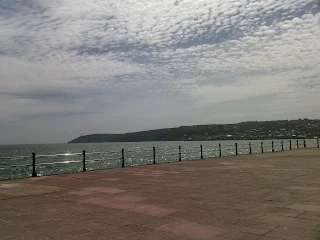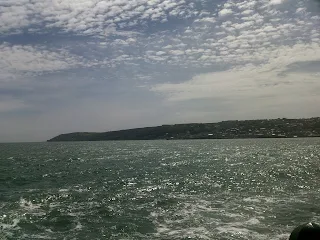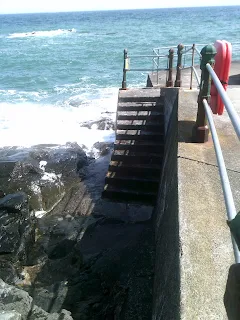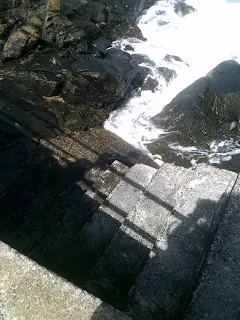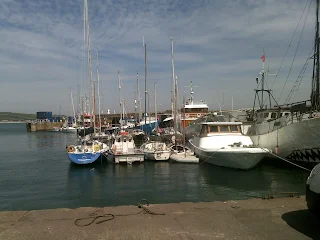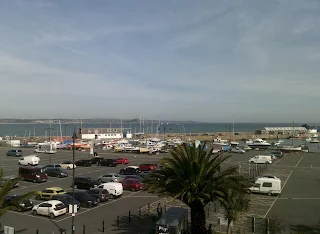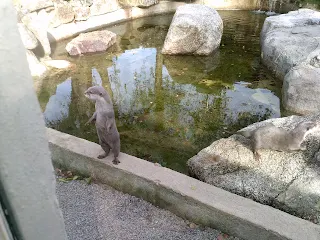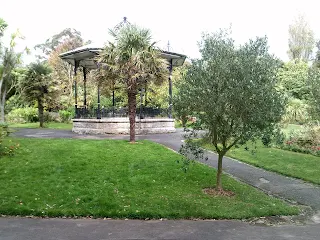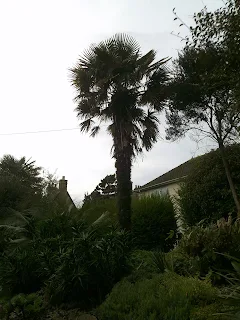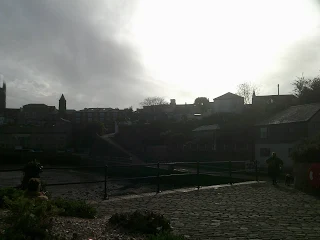The heading is a bit non-specific as I'm covering more than one Cornish place that I've visited and blogged about before, and I've added the relevant links where applicable- such as this one, detailing my previous Hayle experience:-
We stayed at Riviere Sands, which is a holiday park situated by Hayle Towans (Towan is an old Cornish word for sand dune). Hayle is 17miles (27 km) from Land's End, and part of the area known as the Cornish Riviera.
It's the most clement part of Britain, evident with these sunflowers still blooming in October. We saw them every time we took the bucolic walk into town and back.
Here is a view from the bridge over the Great Western Railway line, facing in the direction that leads to Paddington Station, London.
Isambard Kingdom Brunel was the engineer in charge of the creation of this behemoth, and you can see Hayle Viaduct in this photograph. The railway line and the viaduct date from 1852.
Gazing the other way towards Penzance, which is only two stops and twelve minutes away...
A calm beach view, overlooking St Ives across St Ives Bay...
Looking the other way, towards Godrevy Island...
This was taken during my beach walk, on a moody day that offered up the occasional spit of rain.
The lump in the distance is Godrevy Island. On it is Godrevy Lighthouse, inspiration for Virginia Woolf's 1927 novel To The Lighthouse; although she set her story in the Hebrides. I've read it, and I found her "stream of consciousness" style rather skittish and trying.
The current is actually quite vicious, and gouged deep ravines into the sand. I had to jump some of these channels as they were fetlock deep. With the ones I waded through, I waited until the water was on the ebb, otherwise they were cloudy with sand, and I like to be able to see where I'm putting my feet thank-you-very-much!
Paradise Park Wildlife Sanctuary mainly consists of aviaries, with a few other animals in residence as well.
I've been before, so here's the link to my previous experience, which is more specific:-
There are three red pandas, named Jai-Li, Suri and Scarlet at Paradise Park. We only saw two of them- we have no idea which two!

They are very shy animals who spend a lot of time up in the trees. But on this day they were happy to come and play at ground level.
The beautiful Scarlet Ibis is native to South America and the Caribbean...
The red squirrels were extremely hyperactive, and had obviously had too much caffeine that morning! This one did pause to pose and show us his nuts, though.😉 This photograph is by the SuperDean- you can see my pink cardigan and camera strap to the side...
Cute guinea pigs in their barn...
Outside there were goats and sheep, which we got to feed. It was fun, but it's impossible to take pictures of the hungry little beasts when you have your hands full with feed, and wet muzzles in your palms!
There are four donkeys, named Jasmine, Basil, Periwinkle and Lily. As we don't speak fluent Eeyore, we had no idea which one this poser was...😁
There is a rather sad tale attached to Talis, the golden eagle. She's a rescue animal who was bred in captivity, and housed in someone's kitchen in filthy, inhumane conditions. I mean, what kind of person keeps a golden eagle in their kitchen? Someone who's not right in the head, that's for sure.
Luckily she was rescued, and her previous owner fined and banned from keeping animals.
She's a beautiful bird, although apparently she's still a bit nervous. Her story is pinned to the outside of her cage, and strangely I read and remembered her name as "Tails," and it was only on re-reading the Paradise Park website that I realised my mistake.
Caribbean flamingos doing their up-on-one-leg ballet balancing poses for me...
Otters are another animal who are shy, and it's not often that we get to see them. They remained totally elusive at Blackpool Zoo, are choosy when they decide to put in an appearance at Chessington World of Adventures and indeed, this is the only time they've paid any attention to us at Paradise Park.
These little fellows are called Bruce and Willis, and are Asian Short-clawed Otters.
They are nocturnal creatures who need secluded places in which to rest during the day, getting distressed if disturbed too much.
On this day, we were honoured by this display of catwalk expertise...
Our first night didn't offer us up much of a sunset view. I had to try and guess where the sun was, exactly...
We had dinner at the Bluff Inn one night, and these are taken from inside. Here the sun is disappearing, with a bit o' added glare...
The sunsets were occurring at around 6.15 each evening. I like the way the glare on this photo has highlighted, rather than detracted from the orb shape of the sun...
All gone...
The Bluff Inn gets some criticisms, but we thoroughly enjoyed our meal. SuperDean had a burger with chips, onion rings and a side of garlic bread with cheese, and I had crab Caesar salad as I love, love, love crab...
(Washed down with copious amounts of white wine, of course...😉)
Walking down to Hayle Towans another evening, and I adore this heart-shaped indentation in the ground. It's on the walk down to the beach, to the area in sight of the Hayle webcam, where I stood to take my outside photos some evenings...💚
An unspoilt view of the sunset.
Blissful.😊
The sun was much further out to sea along the headland, about where the land meets the water, when we last visited in May last year.
Peer hard and you can see a lonely ship making its way across the horizon...
The two photos above were taken using my phone. Here are the same two views taken using my camera. They look darker, but offer a more contrasting silhouette...
I think I prefer the phone version for the above view, but this camera picture for this view. Somehow, it's more dramatic...
Taken on our final evening and the sun is looking weaker- or is that a psychological thing to think that? Well, it was mid-October...
Fading...
We concluded our holiday with three nights in Penzance, which we've visited before on a day trip from Hayle. Here is that blog link:-
We were booked in to see an exhibition at the Penlee Gallery but were early, so we took a walk through nearby Morrab Gardens.
Morrab House, with its walled garden was built by wealthy brewer Samuel Pidwell, in 1841...
In 1888 the property was bought by the Corporation of Penzance, with the gardens re-designed and opened to the public the following year. Penzance Private Library moved into Morrab House, becoming Morrab Library, and it's still in use as a library to this day...
The bandstand was opened in 1905 and extensively renovated in 2004...
Taken from the elegantly restored bandstand...
The cast iron fountain was beautiful from a distance...
The sprouting fountain originally used water sourced from a natural spring.
...And even better closer. The lower section consists of cherubs riding on tortoises...💙
I'm not sure of the significance of the cannon- they were in no way labelled, and perhaps were just decorative...
Although they have been renovated over the years, the gardens retain their original layout and curvilinear walks...
White fronds of a spiky-leafed plant spewing out from the wall...
The subtropical climate allows plants sourced from Australia, Africa and the Americas to grow to maturity.
Palms are my favourite kind of tree- yes, this more temperate climate certainly suits me!
The garden was designed by Reginald Upcher, a London based designer. The garden is a three acre site, and he won 20 guineas as the Borough had opened a competition to find the best design.
There is also a Boer War Memorial statue dedicated to those who lost their lives in the South African campaign in here, erected in 1904, but somehow we missed that - oh well, there's my excuse to return to Penzance (amongst others!) and the gardens sorted...😄
Penlee House Gallery and Museum was originally built as a house for the affluent Branwell family (ancestors of the Bronte sisters, on their mother's side) in 1865. The house was sold to Penzance District Council in 1946, and formally opened as a museum in 1949.
There was a fantastic exhibition called Newlyn School Interiors showing; which included works by Stanhope Forbes, Elizabeth Forbes and Walter Langley. Part of the Newlyn School group of artists, they depicted realistic scenes of life from Victorian Newlyn. Newlyn is a fishing village adjacent to Penzance, and the art colony was formed by artists attracted to the area by its cheap living costs, astounding natural light and their interest in the everyday lives of fisherfolk.
Piece of useless information- we were booked to stay in the Westbourne Guest House, which was once the home of Walter Langley, but lockdown meant we had to cancel and rearrange our entire break, so it didn't happen. At the time, I kept referring to the hotel as "The artist's house!"
Here is a PDF pf my favourite painting in the exhibition:-
A Hopeless Dawn, 1988, by Frank Bromley (1857-1915).
A young woman cries on the lap of her mother-in-law, as her husband is lost at sea. The relentless ocean can be seen raging through the window.
We walked through the gardens, and this photo was taken at the bottom, looking out over the sea. Could I live here? I think so.
I was convinced that this interesting plant was plastic, and had to reach out and jab my fingernail into it (just a small corner of red leaf, you understand!) to convince myself otherwise.
It was well-and-truly real, and a little research reveals that it's a Fascicularia bicolour, which is also known as a crimson bromeliad. It's a hardy perennial, meaning it's long-living, and can survive in open air all year round. I suppose a plant would have to be to be able to flourish in this mild, yet exposed, environment. You are within sight of the sea, after all...
The Union Hotel was here in Elizabethan times, when it was thought to be the manor house of Penzance. It witnessed the Armada and also the Spanish attack on the town on July 24th 1595, when it was set on fire by invaders. We didn't go in, but apparently smoke-blackened walls can still be seen in the Nelson Bar.
It is from the Minstrels' Gallery in the Assembly Room that the death of Nelson, and the victory of the Battle of Trafalgar was first announced in this country in November 1805.
This unusual building dates from 1835-36, and is known as the Egyptian House.
It is thought to have been built by John Lavin (although there is some dispute as to whether he was the architect or not), a mineralogist and Egyptologist.
Later neglected, its refurbishment was revealed in 1973. It is now divided into three holiday apartments. Whilst I was photographing it I got talking to an old boy on the pavement, and he mentioned that his children had treated him and his wife to a few nights there for their wedding anniversary. What a lovely gift- rooms are close to £100 a night even for an October weekday.💜
This house was once the home of Maria and Elizabeth Branwell- they were the mother and aunt of Charlotte, Emily and Anne Bronte. Maria was from a prominent Penzance family, and left for Yorkshire when she got married in 1812.
The Abbey Basin Quays and Slipway.
This is where boats can sit in dry dock. Abbey Slip, to the right, leads up onto the main section of the town.
To the left of this similar view you can make out St Mary's Church. The present building dates from 1835, although the use of the site for worship dates back possibly as far as the 12th century.
One final glance down a side street, and the Scillonian III was sitting in the dock, having a day off. It doesn't sail every day in October.
The SuperDean outside our Premier Inn hotel, eyeing the pirates mural.
Of course, the obligatory scum had graffitied on this wall...
The Royal Albert Bridge was opened in 1859, was designed by Isambard Kingdom Brunel and carries the Cornish Main Line Railway (which runs from Penzance to Plymouth), part of the Great Western Railway.
This was taken from the train. I'd left Saltash and was approaching Plymouth, and it's hard to take a photo of a bridge whilst your actually on it- I don't think I've done too badly, though!
The bridge spans the River Tamar...
If you want a more detailed review about Plymouth, then I've been there before, and here is the link:-
I will return down this way again- I want to visit the Scilly Isles for a few days in the future, and that will involve a stop-off in this part of the world.
Until then,
TTFN
The Miss Elaineous
XXXXX
XXX
X



